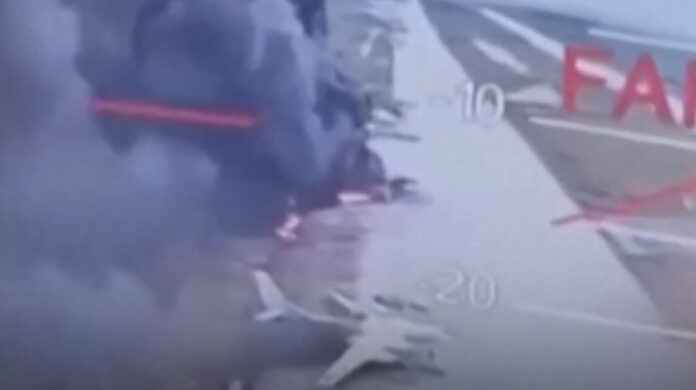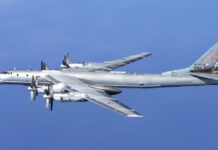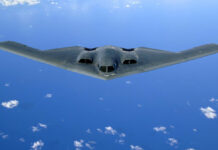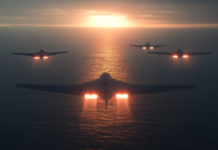
In case you have not been paying attention, a Ukrainian secret attack 18 months in the making resulted in up to 40 long-range nuclear-capable Russian bomber aircraft being damaged or destroyed. The attack came 24 hours before peace talks were supposed to take place in Istanbul.
Although there is a mish-mash of information out there, the attack is believed to have used quadcopter drones which were hidden in the roofs of wooden sheds. The sheds where were then shipped by truck to locations near four major Russian airbases. At a predetermined time, the shed roofs were remotely opened and the drones lifted off, heading for the nearby bases where they struck the strategic bombers as they sat in unprotected locations near runways. The Russian truck drivers were apparently unaware that they carried a deadly load.
Strategic Bombers Targeted
There has been a great deal of news coverage that these bombers are part of Russia’s strategic nuclear triad, which includes the bombers, land-based ICBMs, and submarine-launched ICBMs. Some talking heads speculate that this could result in Russia resorting to the use of nuclear weapons, leading to the big question: did Ukraine cross a red line with this attack?
My guess is that Ukraine did not attack these bombers because they are part of the nuclear triangle, but because they have been used to attack Ukraine with air-launched cruise missiles. The aircraft allow Russia to launch missiles from well within their own territory in what is known as a stand-off attack. As a result, their bombers are virtually immune to Ukrainian counter attack when they launch the missiles. Ukraine found a way to attack the bombers while they were on the ground rather than a moving target.
Will this lead to a nuclear response from Russia? It’s possible, but I tend to doubt it. First, this is far from the first red line Ukraine has crossed. Second, Russia knows there would be consequences.
But some response will be needed, and since Russia is already launching hundreds of drone and missile attacks some nights, Ukraine should expect a new level of airborne attack. If I were in Russia’s shoes I would do something like launch 1,000 missiles and drones, and near the end of that attack, when Ukrainian anti-air missiles are depleted, I’d follow it up with ground-attack aircraft and fighter jets targeting their F16s, the Patriot missile systems, and other key military targets. Destroying these critical western-supplied targets would not only allow Putin to save face, it would be a way of striking back at NATO and the U.S. without striking targets outside Ukraine.
Was the U.S. Involved?
I have heard talking heads speculate the U.S. provided targeting information, but anyone with Google could find those airbases. I have also read reports like this one from the Wall Street Journal, “Ukraine didn’t provide advance notice to the Trump administration of its drone strikes against Russia’s air bases, a senior U.S. official said.” (Notice they didn’t say they were unaware of it.)
Who can we believe? No one. Just like Russia won’t admit they have tried to blow up DHL flights, NATO forces are unlikely to admit they played a role in taking out 40 Russian aircraft.
But coming four days after Trump said “Putin is playing with fire” when Putin appeared to step away from the peace table, the timing is suspicious. Is this Trump sending a message, or is it Ukraine taking advantage of the situation to make it look like Trump is sending a message? We’ll have to wait for the tell-all books in five or six years. Assuming, of course, we aren’t scrambling to survive in a post-nuclear war era where tell-all books make great kindling.
Drone Warfare
In the three years of war, Ukraine has advanced drone warfare further than it would have gone in a decade if there was no war. Drone swarms were once little more than science fiction; now they are an every-day occurrence. Drone used to require an operator; these reportedly used AI. Drones are upending conventional warfare, or at the very least adding a new, challenging dimension to it.
The U.S. and many first-world militaries are desperately searching for a defense against drones where one shot from the counter weapon doesn’t cost more than the drone. Lasers and electronic disruption appear to be the most promising. Until they are perfected, automated 20mm cannons may be the best bet. But what may work on a naval ship in the middle of the ocean faces challenges on land, and we have a great deal of land to protect.
In the meantime, better check those containers from China a little more closely.
Peace Prospects
Does this attack, which Zelensky celebrated, help or hurt peace prospects? It might show Russia that the stakes are higher than ever, or it might make them want to escalate in retaliation. With European powers allowing Ukraine to use western-supplied weapons to attack deeper into Russia, this could be the first of wave of attacks that not only reach Moscow, as they have lately, but go deeper into the country where there is not as much air defense. it could also lead to renewed attacks by both parties.
My best guess is that agreeing to a ceasefire or a peace plan in the immediate aftermath of such an attack would look too much like capitulation for Putin to stomach. While this clever attack might make Russia think twice, I don’t expect any results from Monday’s talks.
Russia lost helicopters and attack aircraft in the early days of the war, lost parts of its navy in the Black Sea, saw key pipelines and refineries attacked, has had hundreds of thousands of men killed or injured, and now has lost 34 percent of its heavy bombers, an irreplaceable part of its air force. While Ukraine appears to be losing the ground war, attacks of this nature make it harder to claim Russia is winning.






